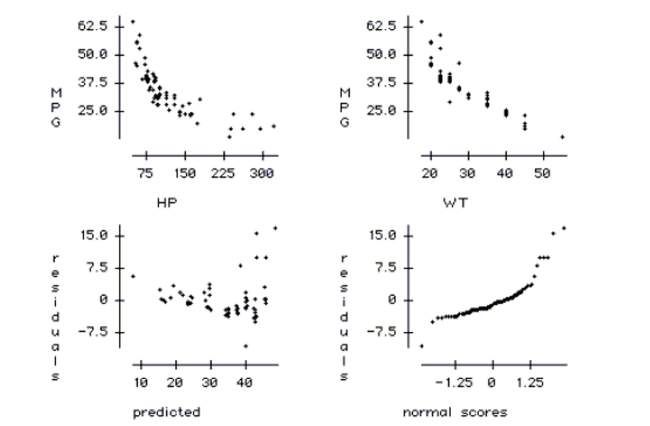Engineers want to know what factors are associated with gas mileage. The regression
below predicts the average miles per gallon (MPG) for 82 cars using their engine
horsepower (HP) and weight (WT, in 100's of pounds). Dependent variable is MPG
squared R squared (adjusted) with degrees of freedom
a. Write down the regression equation.
b. Write down the hypotheses for the test of the coefficient of horsepower. Conduct the test
and explain your conclusion in the context of this problem.
c. Write down the hypotheses for the test of the coefficient of weight. Conduct the test and
explain your conclusion in the context of this problem.
d. Explain the meaning of the coefficient of weight in the context of this problem.
e. Explain the meaning of the intercept of this regression in the context of this problem.
f. Compute the predicted gas mileage of a 3500 pound car with a 150 horsepower engine.
The plots are MPG vs. HP, MPG vs. WT, residuals vs. predicted values, and a normal
probability plot of residuals. 
g. Check the conditions of this regression and comment on whether they are satisfied.
Definitions:
Public Good
A product or service that is provided without profit to all members of a society, either by the government or a private individual or organization.
Public Good
A good that is non-excludable and non-rivalrous, meaning its consumption by one individual does not reduce its availability to others and people cannot be effectively excluded from using it.
Public Good
A good that is non-excludable and non-rivalrous, meaning it can be used simultaneously by more than one person without reducing its availability to others.
Flat Road Tax
A fixed-rate tax imposed on vehicle owners, irrespective of the vehicle's value, emissions, or usage levels.
Q2: A store manager counts the number
Q17: The following table gives the US
Q23: A nurse measured the blood pressure of
Q25: Many school administrators watch enrollment numbers for
Q31: The midterm test scores for the
Q34: Management decided to extend the incentive program
Q68: To avoid working late, a quality control
Q88: Name and describe the kind of bias
Q120: What is the probability that at least
Q121: Describe to the group an advantage and